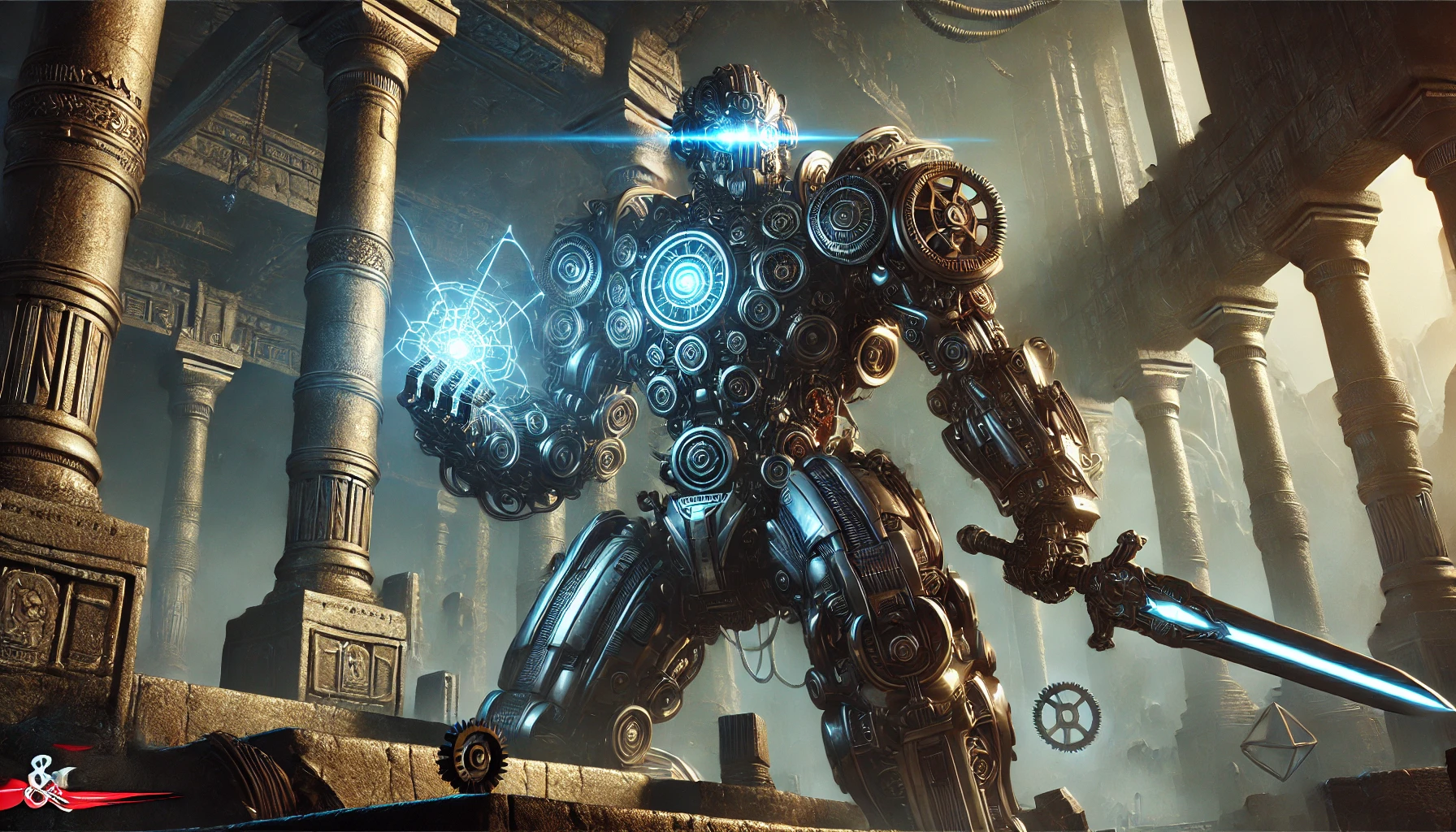Entertainment
5e Automaton Enemies: Powerful Mechanical Foes and How to Defeat Them

Introduction to Automatons in D&D 5e
In Dungeons & Dragons 5e, automaton enemies are mechanical creatures built for different purposes. Some serve as guards, others as warriors or even ancient relics from forgotten civilizations. These constructs have no feelings, no fear, and no need for rest. They follow commands without hesitation, making them dangerous foes in any campaign.
Many adventurers encounter automatons in ancient ruins, hidden laboratories, or strongholds of powerful wizards. Some were built centuries ago and still function, even when their creators are long gone. Automatons do not think for themselves. They follow pre-programmed instructions, making them reliable but predictable enemies.
Definition and Role of Automatons in the Game
An automaton in D&D 5e is a construct—a creature made from metal, stone, or other materials, brought to life by magic or advanced technology. Unlike living creatures, automatons do not eat, sleep, or breathe. They do not age. They exist to perform specific tasks given to them by their creators.
In combat, 5e automaton enemies come in many forms. Some are small, nimble scouts, built to gather information. Others are massive war machines designed to crush anything in their path. Some automatons guard treasure vaults, while others protect ancient knowledge hidden in magical libraries.
Players often face these mechanical foes when exploring dungeons, abandoned temples, or magical workshops. Automatons challenge adventurers in unique ways. Unlike living enemies, they are immune to many effects, such as poison or mind control.
Historical Context and Evolution Within D&D Lore
Automatons have been a part of Dungeons & Dragons for a long time. Earlier editions introduced mechanical guardians, golems, and other constructs, each with unique abilities. Over time, D&D 5e expanded the variety of these mechanical creatures.
In some settings, automatons were created by ancient civilizations with advanced magic and technology. Some legends speak of entire cities built and maintained by these mechanical beings. Over the centuries, many of these constructs continued their work, even as their creators vanished. Some wander the ruins of fallen empires, searching for orders that no longer exist.
Other automatons are more recent creations. Wizards and artificers build them to serve as protectors, assistants, or tools of war. Some factions, like the Emerald Enclave or the Lord’s Alliance, use constructs to guard their secrets. In worlds with high levels of magic, automatons can be found almost anywhere—patrolling city streets, guarding royal vaults, or acting as enforcers for powerful rulers.
Many 5e automaton enemies have no concept of good or evil. They follow their programming. Some are ruthless killing machines, while others act as simple defenders. Their lack of emotion makes them both terrifying and fascinating foes for adventurers.
Characteristics of Automatons in D&D 5e
Automatons are mechanical constructs, built with magic and advanced craftsmanship. They do not have feelings or free will. They follow orders given by their creators or the programming they were built with. Some act as loyal guardians, while others exist only to destroy.
Unlike living creatures, 5e automaton enemies do not feel pain, hunger, or exhaustion. They do not need to sleep. They do not age. They are designed for specific purposes and continue their tasks until they are destroyed or reprogrammed.
Constructed Nature and Immunities
Automatons are classified as constructs in D&D 5e, which gives them several advantages in combat. Since they are not living creatures, they have immunities and resistances that make them tough enemies.
- No Need for Food, Sleep, or Air – Automatons do not eat, breathe, or sleep. They can function indefinitely without rest.
- Immunity to Poison and Disease – Since they have no biological systems, poison and disease do not affect them.
- Resistance to Non-Magical Attacks – Some automatons are made of metal or stone, giving them natural resistance to weapons that are not magical.
- No Mind to Control – Spells that target the mind, such as charm person or fear, have no effect on automatons. They do not feel emotions, making them immune to many enchantments.
Because of these traits, 5e automaton enemies can be frustrating opponents for adventurers who rely on mind-affecting spells or poison-based attacks. Fighters and spellcasters must use different strategies to defeat them.
Common Abilities and Traits
Most automatons have built-in abilities that make them efficient in combat and defense. These abilities vary based on their function and design.
- Darkvision – Many automatons are equipped with sensors that allow them to see in complete darkness.
- Unwavering Loyalty – Automatons follow orders without hesitation. They do not surrender, run away, or question their commands.
- Self-Repairing Mechanisms – Some automatons have the ability to repair themselves over time, making them difficult to defeat.
- Energy Weapons – Some advanced automatons use built-in magical weapons, such as laser-like beams or shock attacks.
- Flight or Enhanced Mobility – Some constructs have mechanical wings or wheels, allowing them to move faster or fly over obstacles.
These abilities make automaton enemies in 5e adaptable foes in different environments. Some are built for war, while others are designed for stealth or surveillance.
Variations in Design and Purpose
Automatons come in different shapes, sizes, and functions. Some are small, designed for scouting or delivering messages. Others are massive, acting as living siege weapons.
Here are a few common types of 5e automaton enemies:
- Guardian Constructs – Built to protect treasure vaults, libraries, and temples. They remain dormant until an intruder appears.
- Battle Automatons – Designed for war, equipped with heavy armor, weapons, and high durability.
- Scout Drones – Small, fast, and often equipped with stealth abilities. They gather information and report back to their masters.
- Clockwork Soldiers – Humanoid in shape, designed to mimic the movement of living warriors. Often used as royal guards.
- Arcane Sentinels – Automatons powered by strong magic, capable of casting spells or absorbing magical attacks.
- Abandoned Constructs – Some automatons outlive their creators and continue to follow outdated orders. These constructs can be unpredictable and dangerous.
Automatons are found in dungeons, cities, and battlefields. Whether they serve as ancient relics or modern inventions, 5e automaton enemies present unique challenges to adventurers. Understanding their design and purpose can help players prepare for encounters against these mechanical foes.
Types of Automaton Enemies in D&D 5e
Automatons in Dungeons & Dragons 5e come in many forms, each designed for a specific purpose. Some are built for combat, while others serve as scouts, defenders, or knowledge keepers. Each type has unique strengths, making them formidable foes in different situations.
Skirmisher Automatons
Skirmisher automatons are built for speed, agility, and rapid response. These constructs are lightweight and designed for quick movement, allowing them to outmaneuver slower opponents.
Designed for Speed and Agility
- Skirmishers are often small or medium-sized, with sleek, streamlined bodies.
- They have enhanced mobility, allowing them to dodge attacks and reposition easily.
- Some have hovering or rolling mechanisms, enabling them to move swiftly across rough terrain.
Roles in Scouting and Outmaneuvering Opponents
- Used as reconnaissance units, they gather intelligence on enemy movements.
- In battle, they act as harassers, striking quickly and retreating before opponents can react.
- Some are messenger constructs, delivering information to higher-ranking automatons or commanders.
Adventurers facing skirmisher automatons must rely on area-of-effect attacks or strategic positioning to pin them down before they escape.
Directus Automata
The Directus Automata is a tactical construct designed for combat efficiency and battlefield control. These automatons serve as frontline enforcers, often leading groups of other mechanical units.
Capabilities and Unique Features
- Directus models are heavily armored, making them difficult to damage.
- Some versions have integrated weapons, such as built-in crossbows, energy projectors, or rotating blades.
- They are programmed with adaptive tactics, allowing them to adjust strategies based on enemy actions.
Tactics Employed in Combat Scenarios
- Formation fighting – They move in coordinated groups, covering each other’s weaknesses.
- Target prioritization – Directus automatons scan battlefields and attack the most dangerous threats first.
- Damage resistance – Many are made of reinforced materials, reducing physical and magical damage.
Fighting a Directus Automaton requires teamwork, as these constructs are designed to counter solo attackers with overwhelming force.
Library Automatons
Library automatons are not built for war but instead function as keepers of knowledge and archives. They are often found in ancient ruins, magical libraries, or the vaults of powerful wizards. Though not aggressive by nature, they can be dangerous if provoked.
Functions Within Their Environments
- Maintain records, sort books, and assist scholars with research.
- Enforce library rules, ensuring that no unauthorized personnel access restricted knowledge.
- Some have the ability to analyze spells, identifying magical intrusions.
Potential Threats They Pose to Adventurers
- Non-lethal countermeasures – Library automatons can restrain intruders with magical binds or force barriers.
- Defensive spellcasting – Some can cast protective magic or summon arcane defenses.
- Security overrides – If tampered with, they can activate nearby constructs as reinforcements.
Adventurers trying to sneak past library automatons must rely on stealth or deception, as these constructs can quickly alert stronger defenders.
Terracotta Automatons
Terracotta automatons are ancient constructs, often resembling warriors or guardians from lost civilizations. Unlike metal automatons, they are crafted from hardened clay or stone, giving them a distinct aesthetic and unique combat properties.
Origins and Historical Significance
- Built by ancient emperors, warlords, or powerful sorcerers as tomb guardians.
- Some were designed for ritualistic purposes, standing dormant for centuries before being reactivated.
- Often found in ruins, crypts, or archaeological sites, where they remain hidden until disturbed.
Combat Strategies and Weaknesses
- Unyielding defense – They act as immovable sentinels, guarding specific areas with unwavering dedication.
- Elemental resistance – Many are immune to fire, cold, or poison due to their stone-like composition.
- Weak to impact damage – While resistant to most attacks, bludgeoning weapons can shatter them more easily.
Adventurers facing terracotta automatons must use heavy weaponry or precise strikes to break their hardened exteriors before they can overwhelm with sheer durability.
Each of these 5e automaton enemies presents a different challenge. Whether facing fast-moving skirmishers, tactical war machines, mystical knowledge keepers, or ancient guardians, adventurers must adapt their strategies to survive encounters with these relentless constructs.
Notable Automatons in D&D Campaigns
Automatons appear in many official D&D 5e adventures, often as powerful guardians, ancient relics, or arcane constructs designed for war. Some are minor foes, while others are major antagonists shaping the story. These mechanical beings add depth and challenge to campaigns, forcing players to think beyond traditional combat tactics.
Examples from Official Modules and Adventures
Many D&D 5e campaigns feature notable automaton enemies, each with unique lore and combat mechanics. Here are some of the most well-known examples:
- Shield Guardians (Various Adventures)
- Created as bodyguards for powerful wizards, these constructs absorb damage meant for their masters.
- Found in many campaigns, they serve as elite defenders, immune to many magical effects.
- Notable appearance: Waterdeep: Dungeon of the Mad Mage – A Shield Guardian is found protecting the secrets of Halaster Blackcloak.
- Steel Predators (Mordenkainen’s Tome of Foes)
- These ferocious mechanical beasts were built for hunting specific targets across the multiverse.
- Programmed with a relentless drive, they will pursue a marked target across planes until their mission is complete.
- Their claw and beam attacks make them terrifying assassins.
- Myrmidons (Princes of the Apocalypse)
- Elemental-powered constructs, bound to fire, water, air, or earth, serving elemental cults.
- Unlike traditional automatons, they retain some intelligence and tactical awareness.
- Their connection to elemental energy allows them to deal specialized damage, making them unpredictable in battle.
- Iron Golems (Monster Manual)
- These giant war machines are nearly unstoppable, immune to most spells and resistant to regular weapons.
- Unlike simple automatons, Iron Golems breathe toxic gas, making them even more dangerous.
- Found in ancient fortresses or protecting forgotten treasures, they stand as legendary threats in high-level campaigns.
- Clockwork Horrors (The Wild Beyond the Witchlight)
- Mechanical insect-like creatures, programmed to harvest metal and destroy organic life.
- Found in abandoned workshops and lost civilizations, still following old directives.
- They attack in swarms, overwhelming enemies with relentless efficiency.
These 5e automaton enemies showcase a range of mechanical threats that Dungeon Masters can use to create high-stakes encounters.
Impact on Gameplay and Storytelling
Automatons serve a variety of roles in D&D campaigns, affecting both the story and combat dynamics. Their presence can:
- Create Unique Combat Challenges
- Automatons often ignore fear, pain, and charm effects, making them resilient foes.
- Some are resistant to non-magical attacks, forcing players to rethink their strategies.
- Others have specific weaknesses, like lightning disrupting circuitry or bludgeoning damage shattering their structure.
- Enhance Worldbuilding and Lore
- Some automatons are remnants of lost civilizations, adding mystery to dungeons and ruins.
- Others serve modern factions, such as wizards’ guilds or military forces, reinforcing themes of arcane innovation or technological advancement.
- Their presence can suggest a powerful creator, hinting at future story arcs.
- Act as Major Plot Devices
- A rogue automaton could be the main villain, continuing its programming long after its master has vanished.
- A legendary automaton might guard an artifact, requiring players to solve ancient puzzles or disable security systems before engaging in battle.
- Players could reprogram or befriend certain constructs, turning them into allies or even companions.
Whether found as deadly foes, ancient relics, or unstoppable enforcers, automaton enemies in D&D 5e add depth and excitement to any campaign. Dungeon Masters can use them to challenge players, expand lore, and create unforgettable moments in their stories.
Strategies for Encountering Automaton Enemies in D&D 5e
Fighting automaton enemies in D&D 5e requires more than just swinging a sword or casting fireballs. These constructs are immune to many effects, resist common damage types, and follow programmed battle tactics. Understanding their weaknesses, using the right spells, and taking advantage of the environment can turn a difficult battle into a victory.
Effective Combat Tactics
Automatons are built to withstand damage and follow strict orders, making them predictable but resilient enemies. Here are some general combat strategies:
- Exploit Their Weaknesses
-
- Many automatons are vulnerable to bludgeoning damage, as heavy strikes can break their frames.
- Some constructs have weak spots, such as exposed gears or arcane cores, which can be targeted with precise attacks.
- Lightning-based attacks may cause short circuits, stunning them temporarily.
- Disable Instead of Destroy
-
- Automatons follow programming, meaning clever players can disrupt their directives rather than fight head-on.
- Some enemies can be hacked, reprogrammed, or confused with the right magic or tools.
- Disabling key components, like sensors or movement joints, can limit their combat effectiveness.
- Focus Fire on One Target
-
- Many automatons have high Armor Class and resistances, making long battles dangerous.
- Instead of spreading damage, focus on taking down one automaton at a time.
- Use spells and abilities that reduce their mobility, preventing them from reinforcing each other.
- Avoid Prolonged Engagements
-
- Some automatons self-repair over time, meaning long battles work in their favor.
- If possible, retreat and regroup, attacking with a fresh plan rather than letting them regain strength.
Utilizing Character Abilities and Spells
Different character classes have unique strengths against 5e automaton enemies. Using the right skills and spells can turn the tide of battle.
For Martial Classes (Fighters, Rogues, Barbarians, Monks)
- Use bludgeoning weapons, like warhammers or maces, to shatter automaton bodies.
- Position yourself for sneak attacks (Rogues) or stunning strikes (Monks) to disable key enemies.
- Take advantage of maneuvering abilities like the Fighter’s Disarming Attack or the Barbarian’s Reckless Attack.
For Spellcasters (Wizards, Sorcerers, Warlocks, Clerics, Druids)
- Avoid mind-affecting spells – Automatons are immune to charm, fear, and psychic damage.
- Use lightning damage to potentially disable or slow their reactions.
- Cast spells that control movement, such as Entangle, Wall of Force, or Earthbind, to limit their effectiveness.
- Clerics and Druids can use spells that corrode metal, such as Heat Metal, to weaken automaton defenses.
For Rangers and Artificers
- Track movement patterns – Automatons often follow fixed patrol routes, which can be predicted and exploited.
- Artificers can use tools to jam or override commands, potentially turning constructs against their creators.
- Rangers can use ranged attacks to disable weak spots without engaging in direct combat.
Environmental Considerations During Battles
The battlefield can give advantages or disadvantages when fighting automatons. Knowing how to use the terrain is key.
- Use Terrain for Cover
-
- Automatons often have ranged attacks, so hiding behind obstacles can limit their effectiveness.
- Fighting in tight spaces forces melee-based constructs into choke points.
- Lure Them into Traps
-
- Since automatons follow pre-programmed commands, they are predictable.
- Lead them into pits, collapsing bridges, or magical traps.
- Use spells like Illusory Terrain or Major Image to trick them into bad positioning.
- Exploit Their Lack of Adaptability
-
- Unlike living creatures, automatons cannot improvise when facing new threats.
- If an automaton is programmed to fight in open spaces, forcing it into cramped corridors or unstable ground may cause it to malfunction.
- Use Magic Against Their Power Source
-
- If the automaton is powered by a crystal, runes, or an external energy source, targeting that may disable or weaken it.
- Disrupting the power flow can make them sluggish or completely shut them down.
Fighting 5e automaton enemies requires planning and adaptability. These constructs do not get tired, scared, or distracted, making them dangerous foes. However, their rigid behavior and mechanical nature provide opportunities for creative adventurers to outthink and outmaneuver them. Whether using brute force, clever spellcasting, or environmental traps, players can turn the odds in their favor and defeat these mechanical warriors.
Incorporating Automatons into Homebrew Campaigns
Automatons add a unique element to homebrew campaigns. They can serve as ancient guardians, advanced war machines, or mysterious relics from lost civilizations. Whether they act as minor foes, powerful bosses, or even allies, these constructs create exciting encounters and rich storytelling opportunities.
Designing Custom Automaton Enemies
Creating a homebrew automaton enemy in 5e requires careful planning. Unlike standard monsters, automatons should have unique mechanics that reflect their artificial nature.
Step 1: Define Their Purpose
- Guardians – Protect sacred sites, treasure vaults, or forbidden knowledge.
- War Machines – Built for combat, equipped with heavy armor and devastating weapons.
- Scouts and Spies – Designed for stealth, tracking, and reconnaissance.
- Rogue Constructs – Automatons that have outlived their creators and developed strange behaviors.
Step 2: Customize Abilities
Automatons can have special features to make encounters more engaging:
- Energy Core Weakness – A glowing core that, if targeted, disables or weakens the construct.
- Modular Weapons – The automaton can switch between ranged and melee attacks.
- Self-Repairing – The automaton heals itself over time unless completely destroyed.
- Hacking Vulnerability – Players with Arcana or Thieves’ Tools can attempt to override its programming.
Step 3: Determine Resistances and Weaknesses
- Immunities – Most automatons should be immune to poison, charm, and fear effects.
- Resistances – Many constructs resist non-magical weapons, forcing players to rely on magic.
- Weaknesses – Some automatons may be weak to lightning (short-circuits) or bludgeoning damage (shattering parts).
Balancing Challenges for Player Parties
When adding automatons to a campaign, they should pose a challenge without being unfair. Consider:
- Action Economy
-
- Automatons with multi-attacks, area damage, or legendary actions can challenge high-level parties.
- Giving them support drones or minions balances fights against larger parties.
- Tactical Depth
-
- Automaton enemies should feel mechanical in their behavior. They might have preset attack patterns or follow rigid strategies instead of adapting like a living foe.
- Boss automatons could have stages, where breaking certain parts changes their attacks.
- Combat Variety
-
- Mixing fast skirmishers, heavy brutes, and spellcasting automatons creates diverse encounters.
- Automatons that adapt to player tactics (e.g., learning to counter repeated spells) keep fights engaging.
Narrative Integration and Plot Hooks
Automatons in a homebrew campaign should tie into the world’s history and lore. Here are some ideas to seamlessly introduce them:
Ancient Ruins and Forgotten Cities
- The party uncovers an abandoned civilization where automatons still function.
- A dungeon contains guardian constructs that attack intruders.
War Machines of a Fallen Empire
- A long-dead empire once built war automatons. Now, a forgotten factory has reactivated, producing new machines.
- The party must stop a rogue automaton general from assembling an army.
Corrupted or Rogue Automatons
- A once-loyal automaton has malfunctioned, attacking indiscriminately.
- A powerful wizard’s construct has gained sentience, seeking its own freedom.
Mystical or Divine Constructs
- A god of order and technology created automatons to enforce laws across the world.
- A prophecy speaks of a machine deity, with automatons acting as its messengers.
Playable Automaton Characters
- Players may befriend and reprogram a construct, turning it into a companion.
- A player could be an awakened automaton, searching for its lost purpose.
Homebrewing 5e automaton enemies allows for creative storytelling and tactical combat. With careful design, these constructs can provide challenging encounters, deep lore, and engaging plot twists. Whether they are ancient defenders, mechanical horrors, or rogue AI, automatons bring a unique flavor to any D&D campaign.
Conclusion
Automaton enemies in D&D 5e offer unique challenges, from fast-moving skirmishers to powerful war machines and ancient guardians. Their resistances, immunity to mind-affecting magic, and specialized abilities make them formidable foes. Whether players face stealthy scouts, tactical enforcers, or relics of lost civilizations, these mechanical beings push adventurers to think beyond traditional combat strategies. Dungeon Masters can incorporate automatons in official modules, homebrew campaigns, or custom encounters, using them to enhance both gameplay and storytelling.
For DMs looking to add depth to their world, automaton enemies provide endless possibilities. They can act as protectors of ancient secrets, rogue machines seeking purpose, or tools of powerful factions. With the right balance of challenge and lore, automatons can enrich campaigns, introduce compelling mysteries, and create unforgettable battles. Whether used as minions, bosses, or even allies, these constructs bring a fresh and exciting element to any D&D adventure.
Thank you for visiting our blog! If you enjoyed this post, feel free to check out more interesting and helpful content here.
-

 Law & Personal Injury6 days ago
Law & Personal Injury6 days agoHow to File a Sample Complaint for Sanctions Against an Attorney in Illinois
-

 Fashion1 week ago
Fashion1 week agoWhat are the Differences Between Microlocs vs Sisterlocks?
-

 Entertainment1 week ago
Entertainment1 week agoAura of Vitality 5e: A Complete Guide to Healing and Support in Combat
-

 Entertainment6 days ago
Entertainment6 days agoKamryan Randolph Wrestling: The Journey of a Rising Star in Sports
















